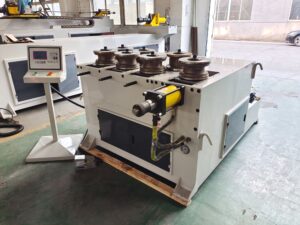However, the traditional pipe rolling process often faces limitations:
- Time-consuming and labor-intensive: Manual operations, such as cutting, bending, and welding, can be time-consuming and require a significant workforce.
- Limited precision and accuracy: Traditional methods often result in inconsistencies and deviations from the desired dimensions.
- High production costs: The cost of labor, raw materials, and maintenance can significantly impact profitability.
Enter the Innovative Pipe Rolling Machine:
- Automated and streamlined processes:
- These machines automate many of the steps involved in pipe fabrication, eliminating manual labor and reducing the risk of human error.
- Enhanced precision and accuracy:
- Advanced sensors and controls ensure precise measurements and consistent pipe dimensions, leading to greater quality and reduced rework.
- Increased productivity and output:
- By streamlining operations and optimizing workflows, these machines significantly increase production capacity and output.
- Reduced costs and improved efficiency:
- Automation, increased precision, and reduced downtime translate into lower production costs and improved overall efficiency.
- Enhanced safety:
- Automated processes and safety features reduce the risk of accidents and injuries associated with manual labor.

Key Features and Benefits of Innovative Pipe Rolling Machines:
The innovations in pipe rolling machines are driven by a relentless pursuit of performance and efficiency.
- Advanced Robotics and Automation: These machines incorporate advanced robotic arms and automated systems for precise and consistent cutting, bending, and welding operations.
- Intelligent Control Systems: Sophisticated control systems, including artificial intelligence and machine learning, optimize the rolling process, ensuring consistent quality and accuracy.
- Integrated Sensors and Data Analytics: Sensors monitor various parameters during the process, providing real-time data and enabling proactive maintenance and optimization.
- High-Performance Hydraulics: Advanced hydraulic systems provide the power and precision needed for seamless pipe rolling and shaping.
- Flexible and Modular Design: Many innovative machines feature modular designs that allow for easy customization and adaptation to different pipe sizes and shapes.
Specific Applications and Industries:
Innovative pipe rolling machines are finding applications across a wide range of industries, including:
- Oil and Gas: These machines are critical for fabricating pipes for oil and gas pipelines, ensuring durability and longevity.
- Construction: They play a crucial role in constructing bridges, buildings, and infrastructure projects.
- Power Generation: These machines are essential for fabricating pipes used in power plants and renewable energy projects.
- Marine Industry: Shipbuilding and offshore platforms rely on these machines for constructing pipes and vessels.
- Pipeline Infrastructure: These machines are used for fabricating pipes for water and sewer lines, gas pipelines, and other infrastructure projects.
The Future of Pipe Rolling:
The future of pipe rolling holds immense promise, with continued advancements in automation, artificial intelligence, and materials science. Here are some of the emerging trends:
- 3D Printing and Additive Manufacturing: 3D printing technology is transforming pipe fabrication by enabling the production of complex shapes and customized designs.
- Internet of Things (IoT) Integration: IoT integration will allow for remote monitoring, predictive maintenance, and real-time data analysis, optimizing operations and enhancing efficiency.
- Sustainable Manufacturing: Future machines will be designed with sustainability in mind, incorporating environmentally friendly materials and energy-efficient designs.
- Enhanced Collaboration: These machines will be integrated with digital platforms and cloud-based systems, facilitating collaboration between designers, manufacturers, and customers.




